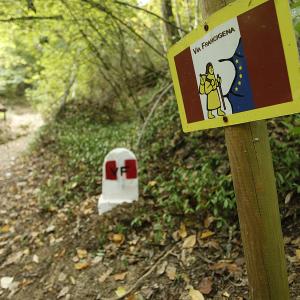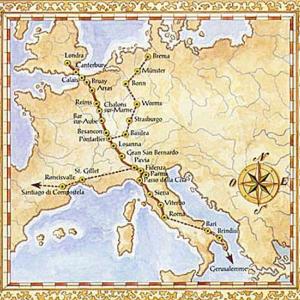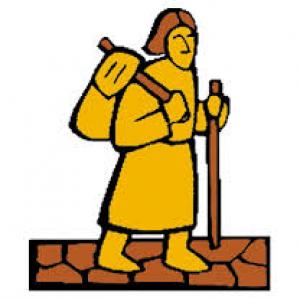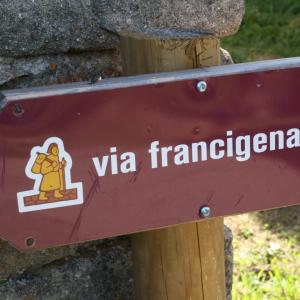THE VIA FRANCIGENA FROM CANTERBURY TO ROME
Starting in the High Middle Ages, the Via Francigena was for centuries the route followed by pilgrims of central and northern Europe to reach Rome, the seat of Papacy and Christianity.
What is today known as the Via Francigena is the 1,800-km route (80 stages) walked in 79 days by Archbishop Sigeric in 990 on his way back to Canterbury after the archiepiscopal investiture of the pallium by Pope John XV. At the invitation of the Pope, Sigeric described each day a stage of his journey back to Britain through Europe. His diary is thus the most authentic record of that time about the Via Francigena route from Rome to the English Channel.
The name "Francigena" did not refer only to a devotional route for the exclusive use by pilgrims, but also to a road travelled by merchants, armies, politicians and artists, a primary channel of communication and exchange fostering those interrelations contributing to the remarkable unity of European culture between the 10th and 13th centuries.
As well as people and goods, the Via Francigena carried ideas and technical and ideological innovations, promoting the exchange and integration of different cultural currents.
Sigeric's route thus becomes a means of exploring European cultural identity in its historical, artistic and religious aspects as well as a real opportunity for local promotion of the areas crossed by the itinerary.
Along the way there were several stops for refreshing soul and body, and to this day we come across a great number of Romanesque buildings and traces that makes us relive past experiences.
The Via Francigena, as can be well imagined, was not a clearly-marked route, but as a series of roads and paths. The pilgrim's journey, therefore, did not consist of a single itinerary, but rather of a network of roads and paths used according to the season, political events and the religious order of the wayfarers, who often came across swamps, marshes, impenetrable woods, adverse weather conditions, dangerous animals and bandits. These circumstances often forced to the pilgrims to look for easier and safer routes, thus creating innumerable local detours over the basic itinerary.
The official route, faithful to the one described by the Archbishop in his Journals, consists of 79 stages. It starts in Canterbury and, passing through France and Switzerland, enters Italy and reaches Rome. it is 1,800-km long and, in its Italian stretch, crosses seven regions - Valle d'Aosta, Piedmont, Lombardy, Emilia Romagna, Liguria, Tuscany, and Lazio - and 140 Municipalities, in a total of 44 stages. The English Via Francigena runs along a short stretch (about 27 km) from Canterbury to Dover which coincides with the North Downs Way. After crossing the English Channel, the pilgrim lands in France, more precisely in the Nord-Pas-de-Calais region. The other French regions included in the route are: Champagne-Ardenne, Picardy and Franche-Comté. Leaving France behind, the Via Francigena route crosses Switzerland through the Vaud and Valais cantons.
The Via Francigena in Italy
Among the many "routes to Rome" that from different parts of Europe and Italy travelled to the capital of Christianity, one of those documented as the oldest is the itinerary called "Via Francigena" or "French" route, as it came from France. Its origin dates back to the Longobard era. When the Longobards established their dominion over northern and central-southern Italy in the 6th century, creating a kingdom with Pavia as its capital, in order to reach their duchies beyond the Apennines they had to find a safe route, away from the routes in Romagna and Liguria, of Roman origin and certainly more convenient, but now controlled by the Byzantines, their implacable enemies.
Therefore they created the Monte Bardone (Mons Langobardorum) route between Fornovo, Berceto and Pontremoli, corresponding roughly to the current Cisa Pass, which they used to reach the ancient seaport of Luni, at the mouth of the Magra river, and the Tuscia region. When Longobard rule was ended by the Franks, the latter extended and consolidated the route in the direction of France (hence the name "francigena", which first appears in documents at this time) and in the direction of Rome and the Papacy, which in Charlemagne and the Franks had found precious allies. It was probably the consolidation of north-south traffic at this time that gave a strong boost to pilgrimages to the sacred places of the Eternal City. It must be remembered, however, that this was not "a" route but a "route area", a set of paths used at different times and possibly with different functions, according to the types of traffic, the political circumstances and the topographical and weather conditions of the different areas.
Not a single Francigena, then, but "many" Francigena routes, which merged at a few key points.
The most travelled passes through the Alps were the Monginevro and Moncenisio, which merged on the Italian side at the Susa road junction. Other access points were the Great and Little St. Bernard passes, which reached the Aosta Valley. One of the passes most frequented by pilgrims was Moncenisio, whose access route to Italy is marked by the ancient Novalesa Abbey and by the monastery of Sacra di S. Michele, erected near the location where Charlemagne's army outflanked the defences put up by Adelchi (the subject of Alessandro Manzoni's tragedy by the same name), the son of Desiderius, the last Longobard King.
Other key stops were Pavia, former Longobard capital, Piacenza, a very important road junction, Fidenza, the junction between the routes in the plain and the Monte Bardone pass and, on the Apennine stretch, the towns of Fornovo and Berceto. Beyond the Apennines, the route touched Pontremoli and Luni. The decline of the Luni harbour, which started in the 8th century, led to the development of Sarzana, Massa and Pietrasanta which, located as they were along the ancient Roman consular road, via Aurelia, became key stops on the Francigena route.
After Pietrasanta, travellers left the coast behind them, as pirate incursions made it unsafe, and continued their journey through Camaiore, Lucca and Altopascio, a town that provided a splendid example of assistance and hospitality, among the best organized in Europe. After Altopascio, the Francigena route touched Val d'Elsa and Siena.
There it joined with the Roman Via Cassia, and went on through Acquapendente, Bolsena, Montefiascone, Viterbo, Capranica, Sutri, and Monterosi. At La Storta, on the outskirts of Rome, pilgrims chose to leave the Via Cassia, which went through unhealth and dangerous areas, taking instead the ancient Via Triumphalis, and reached the Vatican from Mount Mario, called Mons Gaudii ("Mountain of Joy"). St Peter's Square was at that time approached from the right side, from via del Pellegrino and Porta Sancti Pellegrini, along a stretch of road that for a long time was called Ruga Francisca, "road of the French".
Our common European civilization was built over the Francigena route, just as it was over the Santiago de Compostela route. This is why in 1994 the Council of Europe conferred on the Via Francigena the title of "European Cultural Itinerary", as it has on the Santiago de Compostela route to the tomb of the Apostle James, defender of Christianity.

 View Interactive Map
View Interactive Map








